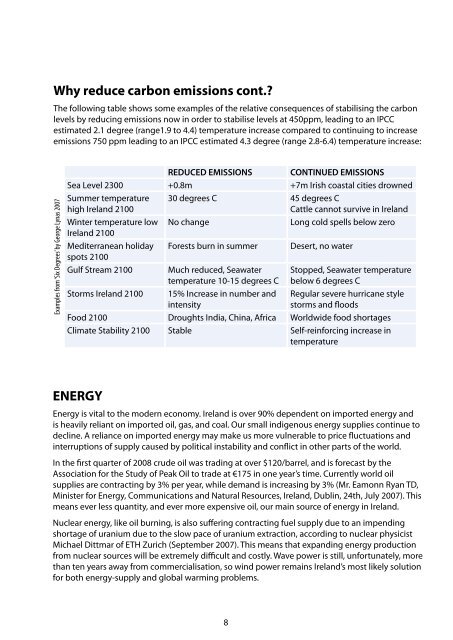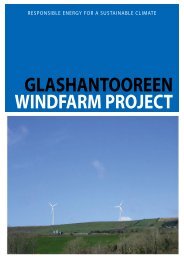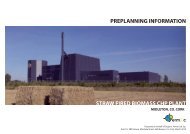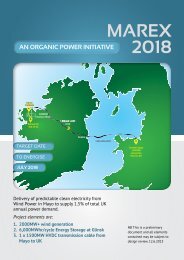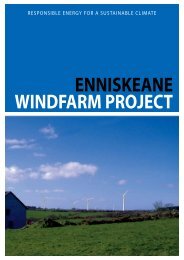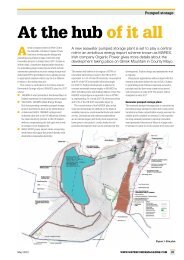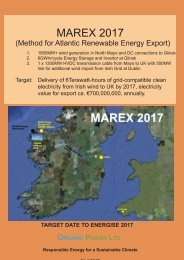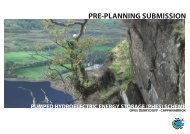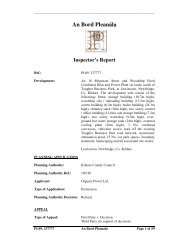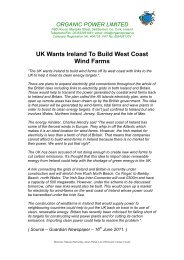DROMLEENA WINDFARM PROJECT - Organic Power
DROMLEENA WINDFARM PROJECT - Organic Power
DROMLEENA WINDFARM PROJECT - Organic Power
- No tags were found...
You also want an ePaper? Increase the reach of your titles
YUMPU automatically turns print PDFs into web optimized ePapers that Google loves.
Why reduce carbon emissions cont.?The following table shows some examples of the relative consequences of stabilising the carbonlevels by reducing emissions now in order to stabilise levels at 450ppm, leading to an IPCCestimated 2.1 degree (range1.9 to 4.4) temperature increase compared to continuing to increaseemissions 750 ppm leading to an IPCC estimated 4.3 degree (range 2.8-6.4) temperature increase:Examples from ‘Six Degrees’ by George Lynas 2007REDUCED EMISSIONSCONTINUED EMISSIONSSea Level 2300 +0.8m +7m Irish coastal cities drownedSummer temperaturehigh Ireland 2100Winter temperature lowIreland 2100Mediterranean holidayspots 2100Gulf Stream 2100Storms Ireland 210030 degrees C 45 degrees CCattle cannot survive in IrelandNo changeLong cold spells below zeroForests burn in summerMuch reduced, Seawatertemperature 10-15 degrees C15% Increase in number andintensityDesert, no waterStopped, Seawater temperaturebelow 6 degrees CRegular severe hurricane stylestorms and floodsFood 2100 Droughts India, China, Africa Worldwide food shortagesClimate Stability 2100 Stable Self-reinforcing increase intemperatureENERGYEnergy is vital to the modern economy. Ireland is over 90% dependent on imported energy andis heavily reliant on imported oil, gas, and coal. Our small indigenous energy supplies continue todecline. A reliance on imported energy may make us more vulnerable to price fluctuations andinterruptions of supply caused by political instability and conflict in other parts of the world.In the first quarter of 2008 crude oil was trading at over $120/barrel, and is forecast by theAssociation for the Study of Peak Oil to trade at €175 in one year’s time. Currently world oilsupplies are contracting by 3% per year, while demand is increasing by 3% (Mr. Eamonn Ryan TD,Minister for Energy, Communications and Natural Resources, Ireland, Dublin, 24th, July 2007). Thismeans ever less quantity, and ever more expensive oil, our main source of energy in Ireland.Nuclear energy, like oil burning, is also suffering contracting fuel supply due to an impendingshortage of uranium due to the slow pace of uranium extraction, according to nuclear physicistMichael Dittmar of ETH Zurich (September 2007). This means that expanding energy productionfrom nuclear sources will be extremely difficult and costly. Wave power is still, unfortunately, morethan ten years away from commercialisation, so wind power remains Ireland’s most likely solutionfor both energy-supply and global warming problems.8


